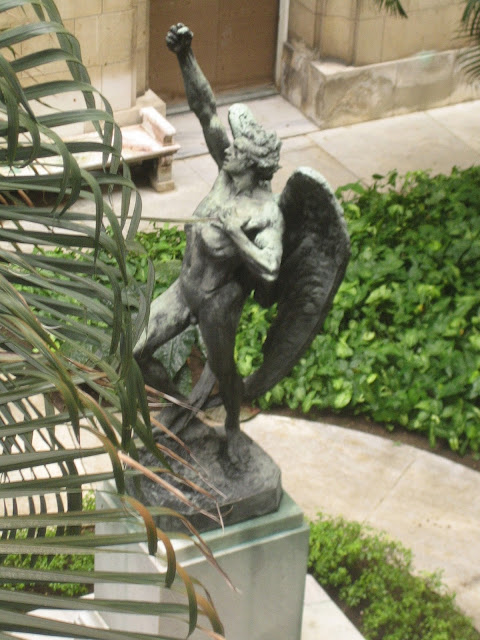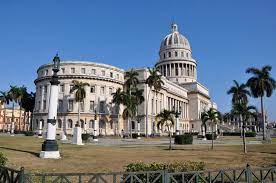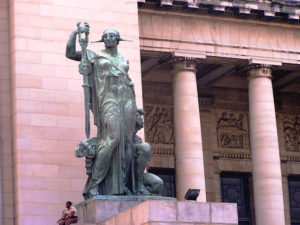LA HABANA, CUBA: LAS MONUMENTALES ESTATUAS DEL CAPITOLIO NACIONAL CUBANO. PHOTOS.
Obras maestras que aún perduran en el mismo centro de nuestra Habana fueron obras del escultor italiano Angelo Zanelli, (durante el gobierno del entonces presidente Gerardo Machado, en el período en que Carlos Miguel de Céspedes era el secretario de Obras Públicas), fue al famoso artistas Italiano a quien se le encargó la realización de tres grandes esculturas que en cierta forma identifican al Capitolio.
Dos de ellas en el exterior a ambos lados de la escalinata, las que representan el Trabajo y la Virtud. La otra estatua, interior, simboliza la República.
A ambos lados del desembarco de la gran escalera, se emplazan dos grupos escultóricos hechos en bronce, La Virtud Tutelar del Pueblo y El Trabajo, de 6,50 metros de altura cada uno.
De Zanelli es también la impresionante estatua “La República” ubicada en el magnífico Salón de los Pasos Perdidos y situada bajo el domo. Hecha en bronce, con 17,54 metros de altura, mide 14.6 metros desde los pies hasta la punta de la lanza y 49 Toneladas de peso, que es una de las más grandes del mundo bajo techo. Después de su emplazamiento se le consideró la segunda estatua más alta del mundo bajo techo, superada por el Buda de Oro de Nava, Japón. Actualmente es la tercera, después de concluido el mausoleo a Abraham Lincoln, en Washington.
LA IMPRESIONANTE ESTATUA DE LA REPUBLICA…
La estatua de la República de Cuba se dice fue inspirada en la modelo habanera Lily Válty, una mestiza criolla de figura agradable. Lily Valty solo brindó su escultural cuerpo, pues la verdadera dueña del rostro fue Elena de Cárdenas Echarte. Para la pieza principal que simbolizaría a la República de Cuba, Zanelli debía servirse de mujeres típicas del país y recordar a Palas Atenea, diosa griega de la sabiduría. Zanelli también la utilizó para esculpir elementos decorativos del pórtico central.
En su cabeza reposa un gorro frigio, como emblema de libertad. Su brazo derecho levantado, lejos de empuñar, sostiene con delicadeza una lanza con aire victorioso, en contraposición con su mano izquierda que descansa sobre el Escudo de Cuba. Es visible su bien definida musculatura en la desnudez de la mayor parte del cuerpo. Una banda estrecha imitando una tela fue esculpida cubriendo una porción de sus partes privadas, lo que le da un aire un tanto sensual.
La majestuosa escultura de bronce laminado en oro de 22 quilates, mide alrededor de 17 metros, incluyendo su base de mármol ónix antiguo egipcio. Solamente el Buda de Oro de Nava, en Japón, y el Memorial Lincoln, en Washington, superan la altura de nuestra colosal estatua. Fundida en Italia (Fonderia G. Chiurazzi, Roma MCMXXIX), para el traslado hasta Nápoles, dividida en tres partes, se necesitó un vagón especial. En día lluvioso fue embarcada hacia Cuba y las tres grandes cajas se subieron en hombros por la escalinata del Capitolio días antes de su inauguración. En esa época se le consideró la mayor estatua de bronce fundida en Italia para el extranjero..¡
A pocos metros de la entrada y del brillante que marca el kilómetro cero de la Carretera Central, justo debajo de la cúpula se yergue serena, con lanza, escudo y gorro frigio, como presta a luchar.
En los tiempos en que se creó esta escultura había gran influencia del fascismo en muchos países, especialmente en Italia con Benito Musolini en el poder. El sistema fascista utilizaba la música, la filmografía y las artes en general como armas políticas con fines propagandísticos para cambiar la ideología de las masas y ejercer control sobre ellas. La arquitectura, por ejemplo, se caracterizaba por la construcción de majestuosas y colosales edificaciones, monumentos y esculturas para que reflejaran lo que ellos consideraban la supremacía de la raza aria. De ahí el considerable tamaño de la estatua en el Capitolio de la Ciudad de la Habana.
ESTATUA DEL DEMONIO EN EL CAPITOLIO CUBANO…
Pero hay algo que llama mucho la atención, y es que hay otra estatua está situada en el mismo capitolio y que representa al demonio. En el patio interior del ala norte del capitolio se encuentra La Estatua de Mefistófeles, al que le llaman El Ángel Caído o el Angel Rebelde, una obra de Buemi, otro artista italiano de los años 30. Por aquel entonces se decía que era símbolo de la discordia y de la controversia.
En muy pocos lugares del mundo se encuentran efigies erigidas a este ángel conocido como Lucifer, pero en ella siempre aparece vencido y humillado. A diferencia de estos otros, este ángel de Cuba es el único en el mundo en actitud desafiante y prepotente, muy lejos de mostrar señales de humillación. Su actitud es de rebeldía, con su brazo derecho levantado hacia el cielo y el puño cerrado en señal de desafío al Creador. Con su mano izquierda se señala a si mismo, como atribuyéndose el derecho de suplantar el lugar de Dios. Si fuera creyente diría que el haberlo ubicado allí representó un castigo para el pueblo de Cuba por todos los sufrimientos que ha llevado a lo largo de su corta vida de un poco más de un siglo.
HAVANA, CUBA: THE MONUMENTAL STATUES OF THE CUBAN NATIONAL CAPITOL. PHOTOS
Masterpieces that still remain in the very center of our Havana were the works of the Italian sculptor Angelo Zanelli, (during the government of then President Gerardo Machado, in the period when Carlos Miguel de Céspedes was the Secretary of Public Works), he went to the famous Italian artists who were commissioned to make three large sculptures that somehow identify the Capitol.
Two of them are outside on both sides of the stairway, those that represent Work and Virtue. The other statue, inside, symbolizes the Republic.
On both sides of the landing of the grand staircase, there are two sculptural groups made of bronze, La Virtud Tutelar del Pueblo and El Trabajo, each 6.50 meters high.
From Zanelli is also the impressive statue “The Republic” located in the magnificent Hall of Lost Steps and located under the dome. Made of bronze, 17.54 meters high, it measures 14.6 meters from the feet to the tip of the spear and weighs 49 tons, which is one of the largest in the world indoors. After its placement, it was considered the second tallest indoor statue in the world, surpassed by the Golden Buddha of Nava, Japan. It is currently the third after the Abraham Lincoln mausoleum in Washington was completed.
THE IMPRESSIVE STATUE OF THE REPUBLIC…
The statue of the Republic of Cuba is said to have been inspired by the Havana model Lily Válty, a Creole mestizo with a pleasant figure. Lily Valty only offered her statuesque body, since the true owner of her face was Elena de Cárdenas Echarte. For the main piece that would symbolize the Republic of Cuba, Zanelli had to use typical women of the country and recall Pallas Athena, the Greek goddess of wisdom. Zanelli also used it to sculpt decorative elements for the central portico.
On her head rests a Phrygian cap, as an emblem of freedom. His raised right arm, far from grasping, delicately holds a spear with a victorious air, in contrast to his left hand that rests on the Shield of Cuba. Her well-defined musculature is visible in the nudity of most of her body. A narrow band imitating a cloth was sculpted covering a portion of her private parts, which gives it a somewhat sensual air.
The majestic 22-carat gold-plated bronze sculpture measures around 17 meters, including its ancient Egyptian onyx marble base. Only the Golden Buddha of Nava, in Japan, and the Lincoln Memorial, in Washington, exceed the height of our colossal statue. Cast in Italy (Fonderia G. Chiurazzi, Rome MCMXXIX), for the transfer to Naples, divided into three parts, a special wagon was needed. On a rainy day, it was shipped to Cuba and the three large boxes were carried on the shoulders of the Capitol steps days before its inauguration. At that time it was considered the largest bronze statue cast in Italy for foreigners…
A few meters from the entrance and the brilliant that marks kilometer zero of the Central Highway, just below the dome she stands serenely, with a spear, shield, and Phrygian cap, as if ready to fight.
At the time this sculpture was created, there was a great influence of fascism in many countries, especially in Italy with Benito Mussolini in power. The fascist system used music, filmography, and the arts in general as political weapons for propaganda purposes to change the ideology of the masses and exercise control over them. Architecture, for example, was characterized by the construction of majestic and colossal buildings, monuments, and sculptures to reflect what they considered the supremacy of the Aryan race. Hence the considerable size of the statue in the Capitol of the City of Havana.
THE STATUE OF THE DEMON IN THE CUBAN CAPITOL…
But there is something that attracts a lot of attention, and that is that there is another statue located in the same capitol that represents the devil. In the inner courtyard of the north wing of the capitol is the Statue of Mephistopheles, which is called The Fallen Angel or the Rebel Angel, a work by Buemi, another Italian artist from the 1930s. At that time it was said to be a symbol of discord and controversy.
In very few places in the world are effigies erected to this angel known as Lucifer, but he always appears defeated and humiliated. Unlike these others, this angel from Cuba is the only one in the world with a defiant and arrogant attitude, far from showing signs of humiliation. His attitude is one of rebellion, with his right arm raised towards the sky and his fist closed as a sign of defiance to the Creator. With his left hand, he points to himself as if claiming the right to supplant the place of God. If he were a believer, he would say that having placed it there represented a punishment for the people of Cuba for all the suffering that he has endured throughout his short life of a little over a century.
Agencies/ Wiki/ MonumentosNacionalesHist./ Extractos/ Excerpts/ Internet Photos/ Arnoldo Varona/ www.TheCubanHistory.com
THE CUBAN HISTORY, HOLLYWOOD.



 LA HAVANA, CUBA: The Monumental Statues of the Cuban National Capitol. PHOTOS. * LA HABANA, CUBA: Las Monumentales Estatuas del Capitolio Nacional Cubano. PHOTOS.
LA HAVANA, CUBA: The Monumental Statues of the Cuban National Capitol. PHOTOS. * LA HABANA, CUBA: Las Monumentales Estatuas del Capitolio Nacional Cubano. PHOTOS.







